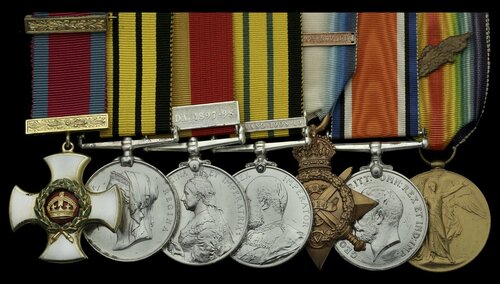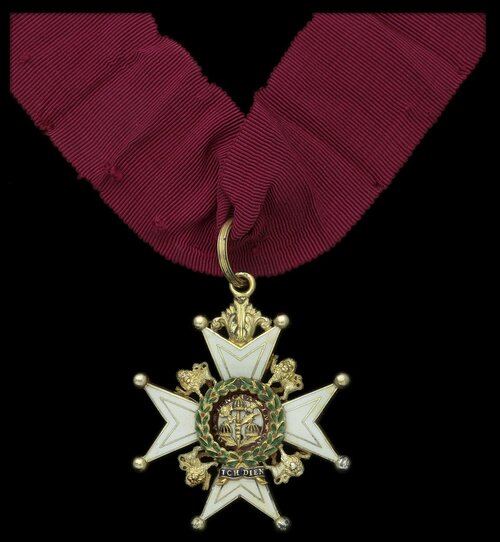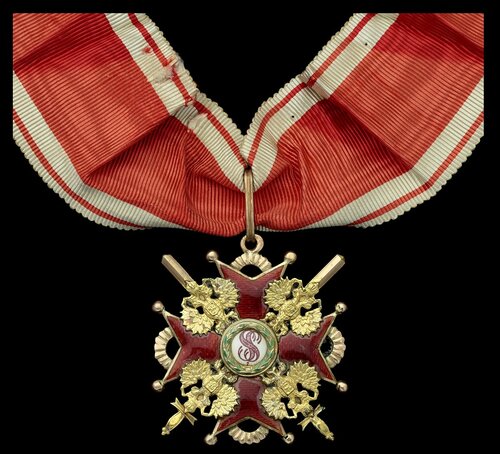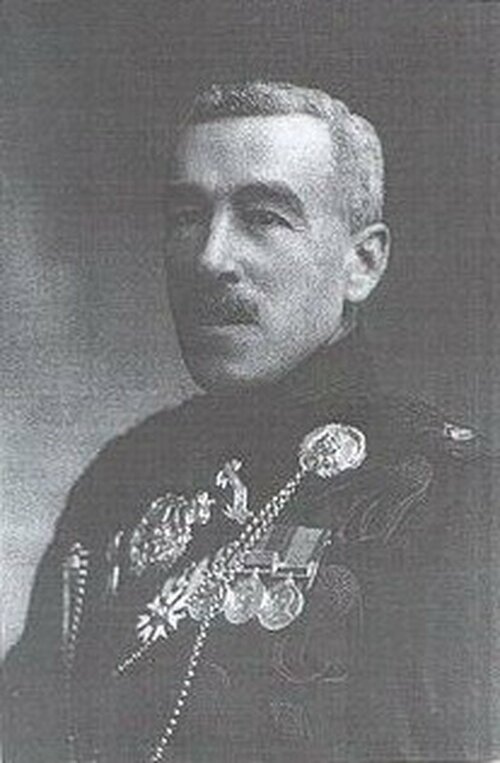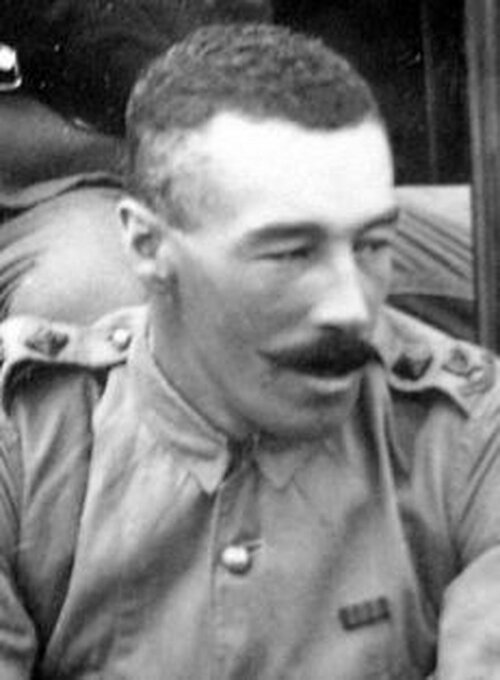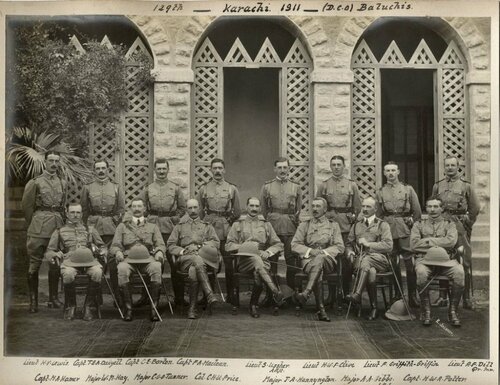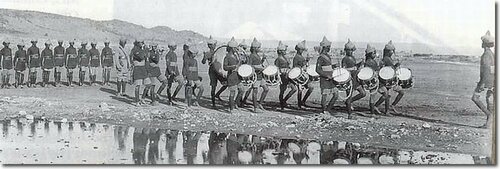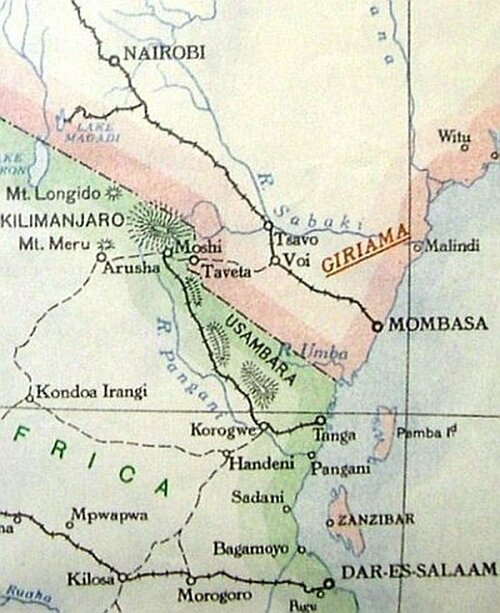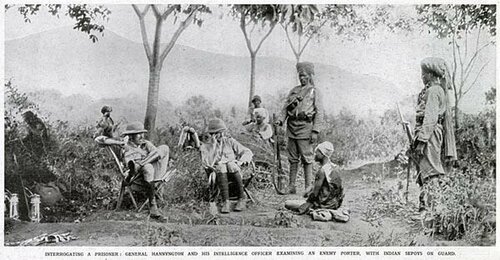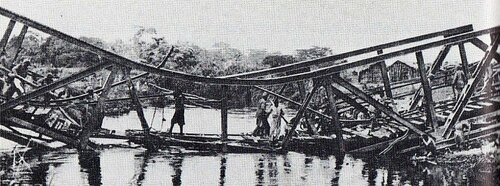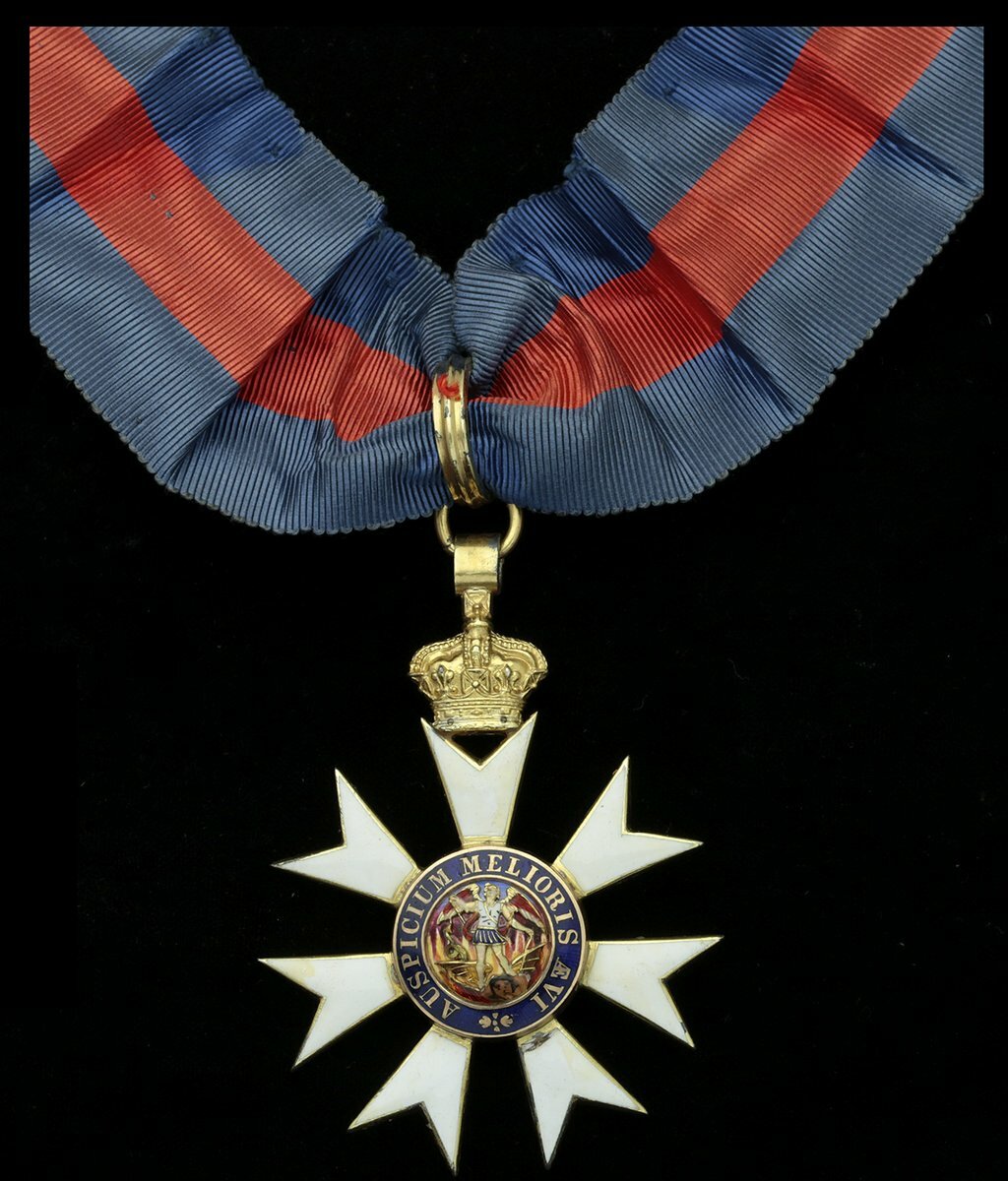Auction: 21002 - Orders, Decorations and Medals
Lot: 216
Sold by Order of a Direct Descendant
A superb 'Somaliland C.M.G.', Great War East Africa C.B., D.S.O. group of ten awarded to Major-General J. A. Hannyngton, Indian Army who served with distinction in three campaigns in Africa with the 29th Bombay Infantry - being wounded in Uganda in 1898 - before joining the 129th Baluchis, besides commanding the 6th Battalion, King's African Rifles in Somaliland
During the Great War he served in Flanders from 1914 and was in at the action which precipitated the first Indian Victoria Cross before returning to Africa to command a column during the East African Campaign; having earned further laurels and no less than five 'mentions', he died of Pneumonia on 21 August 1918 en-route to Egypt
The Most Distinguished Order of St. Michael and St. George, C.M.G., Companion's neck Badge, silver-gilt and enamel; converted from breast Badge, The Most Honourable Order of the Bath, C.B. (Military Division), Companion's neck Badge, silver-gilt and enamel; centres a little depressed, Distinguished Service Order, G.V.R., silver-gilt and enamel; East and West Africa 1887-1900 (Lt J. A. Hannyngton, 29th Bombay Infantry. Mwele 1895-6); East and Central Africa 1897-99, 1 clasp, Uganda 1897-98 (Lt. J. A. Hannyngton, 29/Bo. Inf:); Africa General Service 1902-56, 1 clasp, Somaliland 1908-10 (Major J. A. Hannyngton. 129/(DCO) Baluchis); 1914 Star, with clasp (Major J. A. Hannyngton. 129/Baluchis.); British War and Victory Medals, with M.I.D. oak leaves (Maj. Gen. J. A. Hannyngton.); Great War Bronze Memorial Plaque (John Arthur Hannyngton); Russia, Imperial, Order of St Stanislaus, neck Badge, with swords, gold and enamel, maker's initials and court stamp to reverse, together with wooden velvet-lined display case by Spink & Son, traces of lacquer, very fine (10)
C.B. London Gazette 27 July 1918 (East Africa).
C.M.G. London Gazette 2 January 1911:
'In recognition of services in Somaliland.'
D.S.O. London Gazette 23 June 1915.
Russian Order of St. Stanislaus London Gazette 15 February 1917.
John Arthur Hannyngton was born at Tellicherry, Madras, India on 26 February 1868, the son of John Child and Laura Elizabeth Hannyngton. His father was a Judge with the Indian Civil Service and his grandfather, John Caulfield Hannyngton, had served as a General in India at the time of the Mutiny, although he is better remembered for the invention of the Slide Rule. Hannyngton studied at the United Service College, Devon and spent two years with 5th Battalion, Royal Dublin Fusiliers from 9 July 1887-7 June 1889. He was commissioned Second Lieutenant with 1st Battalion, Worcestershire Regiment on 25 July 1889 and promoted Lieutenant on 2 March 1891.
India
Transferring to the Indian Army on 23 March 1892 Hannyngton joined the Indian Staff Corps, attached to the 19th Bombay Infantry at Poona. Transferring to 26th Bombay Infantry at Sibi on 4 November he remained with them until 16 December, when he joined the 29th Baluch Battalion at Hyderabad. They remained there for several years before moving north to Loralai in 1895.
British East Africa and Uganda
Hannyngton was attached to 24th Bombay Infantry on 2 March 1896 in British East Africa for Field Service lasting from 2 March-12 July of that year. His service record states that he was fulfilling the role of Intelligence Officer for the operations against the Omani Mazrui Rebels during the Mwele expeditions. Returning briefly to India and later to England he was back in Africa by 29 November 1897 attached to 27th Baluch Light Infantry to take part in operations intended to quell the unrest affecting the country at the time. Arriving at Mombasa on 12 December the Regiment was heavily involved in the Teita Hills Expedition 1897-98 and actions against Sudanese troops who had mutinied against British Rule. These men, largely the remnants of Emin Pasha's abandoned garrisons who had held the Equatorial Province for so long against the Mahdist armies, were capable troops as was proven by an incident on 10 October 1898 in which Hannyngton featured heavily. On that day he was leading a party of 30 sepoys towards Masindi, a government strongpoint between Lake Albert and Lake Kioja, unbeknownst to them however they were marching under the guns of a party of mutineers lying in ambush. The critical moment came when Hannyngton halted for a moment to read a message and, seeing himself falling behind his men hurried to return to his place at their head. He had just overtaken the column when the mutineers opened fire, thirteen sepoys including a Jemadar were cut down with another nine wounded. Hannyngton meanwhile was hit in both the upper part of his right arm and had his left hand shattered by a round. The rest of his party opened fire and managed to drive the ambushers back but it was still touch and go as they withdrew towards the fort at Kisiliza near Lake Kioja, held by the rest of their company. The Abergavenny Chronicle states:
'The enemy lost 100 men, but they captured several rifles and some baggage. They afterwards attacked Kisiliza, but were driven off with a loss of 25 men, the casualties on the British side being only two men wounded. Extra troops have been despatched to follow the rebels.'
Despite the severity of his wounds Hannyngton remained in Uganda until 8 May 1899 when he returned to India on medical leave. He was soon posted back to his regiment and remained with them being advanced Captain on 8 June 1900.
Jubaland and Somaliland
Fully recovered by 1901 he was posted to 3rd (East Africa) Battalion, King's African Rifles as a Commandant of the Jubaland Camel Corps. Remaining in this role until 1 January 1904 he was later appointed a Sub-Commissioner, serving in this role while also commanding troops from 1 January 1904-5 January 1905. During this time he was mentioned in a letter from the Secretary of State for Foreign Affairs dated 28 June 1904 and summarised on his service record as:
'Conveying appreciation of services in Jubaland 02-04 in general and capture of Sheikh Ahmed Jama in particular. Thanks of Foreign Office.'
Returning to his role as Commandant on 6 January 1905 this time with 6th (Somaliland) Battalion, King's African Rifles he was to remain with this unit for the next five years during the abortive attempts to control the Somali tribes and in particular the Dervish movement. Hannyngton was promoted Major on 8 June 1907 and remained in Somliland as the situation there became increasingly tense with the rise of Mohammed Abdullah Hassan whom the British called the 'Mad Mullah'. British troops stationed in the area were upon more and more frequently called upon to protect friendly tribes and patrol the roads and villages beyond the coast. Hannyngton's moment in this campaign came on 3 June 1909 when the British commander, Colonel J. E. Gough, V.C., fell ill: temporarily advanced Lieutenant-Colonel and given command, he found himself responsible for co-ordinating the British response across Somaliland. His dispatch of 7 December 1909 makes for interesting reading, describing perfectly the frustrating political situation when his men were called upon to suspend operations to allow for negotiations with the Mullah. Having failed to make a common accord the British recommenced their campaign which proved a dismal affair. The Dervish forces attacked tribes under British protection, ambushed small patrols and caused panic in British-held areas without ever truly coming to a pitched battle. Small skirmishes such as the one on 11 October are described as follows in the same dispatch:
'Camel Company (Indian) of 6th Battalion, moving on patrol to Adad, was attacked by dervishes, losing five rank and file killed and one transport follower. The company put the dervishes to flight, pursuing them for miles, and being joined in the pursuit by C Company, 6th Battalion. The remainder of the 6th Battalion moved out in support.'
These glimpses seem to exemplify the frustration of fighting an enemy who was able to manoeuvre so adroitly without being seen and withdraw to the inaccessible wastes without being followed. During Hannyngton's service the British Government considered the strategy of attempting to hold the interior to be flawed and began a withdrawal towards their strongpoints on the coast centred on Berbera. Colonel Gough made special mention of his service in a dispatch posted in the London Gazette on 19 June 1910:
'Lt. Col. Hannyngton was commanding the 6th Battn. K.A.R. and I handed over command of the troops to him. He always gave me the most loyal support, a good hard working officer.'
Another letter, this time from the Secretary of State for Colonies, on 11 April 1910 draws special attention to his services in evacuating the troops to their new positions on the coast. A second on 23 August that same year again drew attention to his role and it was likely this which precipitated the award of the C.M.G. the next year. Returning from Somaliland in 1910 Hannyngton joined his new regiment, as Second-In-Command of 129th Duke of Connaught's Own Baluchis.
The Great War and Flanders
The Indian Army was mobilised quickly upon the outbreak of the First World War, so quickly indeed that upon arriving in Marseilles on 26 September 1914 the first troops ashore found themselves without appropriate uniforms, having only their light Indian Service Uniform to protect them from the elements. Those troops were members of the Lahore Division who had travelled from Karachi the previous month with Hannyngton's 129th Duke of Connaught's Own Baluchis forming part of Ferozepore Brigade. They made fast progress, entraining on 30th September and reaching the front in October. All was chaos with the German army launching the First Battle of Ypres on the 19th October, attacking the line around the positions of the dismounted Cavalry Corps south of Ypres at Wytschaete and Messines. The Lahore Division was rushed in to support the beleaguered cavalry, who due to the makeup of their regiments could put far less men into the field than an infantry corps, with battalions of sepoys being placed under the command of cavalry divisions. 129th Duke of Connaught's Own Baluchis were attached to 2nd Cavalry Division and sent into the line in support of 3rd Cavalry Brigade south of Hollebeke. They were thrown into the fighting, receiving a baptism of fire for the trenches on 26 October 1914 in an abortive counter-attack launched with no reconnaissance and little planning. Notably they were the first troops of the Indian army to engage the enemy on the Western Front. The attack began relatively late in the day at 15:00 and after two hours of difficult progress a combination of fading light and enemy fire finally halted their advance. Receiving two companies of reinforcement from the 57th (Wilde's Rifles) they dug in around Hollebeke Chateau in support of the much-reduced 5th (Royal Irish) Lancers. Their losses for the day stood at one officer and nine other ranks killed, forty-eight wounded and four missing. Expecting a counter attack at any time they were not disappointed as on 30 October they found themselves subject to a massive artillery barrage which forced them back to the high ground before the Chateau. The next day the attack began at 06:30, coinciding with the arrival of relief for No. '3' and No. '4' Companies who had been in the forward trenches all night with Hannyngton himself commanding No. '3'. While No. '4' Company succeeded in withdrawing in good order, No. '3' was pinned down by heavy artillery fire and forced to take cover in the farm buildings between the trenches and the Chateau. A counter attack led by Colonel Southey managed to free them but the day was still filled with confused and heavy fighting before the British managed to withdraw to the Chateau grounds. Most notably this action also brought a Victoria Cross awarded to Khudadad Khan, the first Indian to win the award, who held his position after the rest of his gun crew were killed firing until he was too injured to carry on, left for dead he managed to take his machine gun's lock and crawl back to British lines. It is entirely possible, and even likely that Hannyngton bore witness to these events or that he was even Khan's commander during the fighting. The Regiment went on to be involved in the fighting at Givenchy as well as the Second Battle of Ypres. However they were not to remain in Flanders for long, Hannyngton was returning to the place in which he had first cut his teeth as a solider and come to the notice of his superiors, East Africa. He went as commander of the 129th Duke of Connaught's Own Baluchis, a role he took in January 1915 being promoted Lieutenant-Colonel on 8 June to go with a 1915 'mention'.
German East Africa
The Regiment arrived on 5 January 1916, much reduced from its original compliment after the heavy fighting in France but reinforced with fresh intakes. Their arrival in East Africa at this point was the culmination of a drive to reinforce British forces in advance of their latest assault upon the Colony. The Regiment was involved in some of the preliminary fighting at the border in early 1916. However when General Stewart, commander of 1st Division was returned to India and General Sheppard replaced him Hannyngton found himself promoted Temporary Brigadier General on 25 March 1916. In this rank he was to command 2nd Brigade including his old Regiment 129th Duke of Connaught's Own Baluchis, 57th (Wilde's Rifles), 3rd King's African Rifles, 40th Pagans and, for a time, 25th Royal Fusiliers (the Frontiersmen). They were into action quickly with a relentless push to clear the Pare Mountains during which 1st Division, including Hannyngton's 2nd Brigade swung around between them and Kilimanjaro in order to cut the German forces off at Kahe simultaneously seizing the vital Tanga railway. 2nd Brigade was particularly heavily engaged in clearing Mkomazi station however they were successful and the hills were cleared in just a fortnight, an act the German settlers of nearby Moshi had thought impossible.
With the Tanga railway secured the British paused, allowing their logistics to realign to the new situation before they began their advance anew. General Smuts' plan was to capture the strategic crossroads of Handeni, allowing him to control traffic and prevent the German forces in the north from linking with Von Lettow-Vorbek's troops. This advance led to a series of hard-fought skirmishes for 2nd Brigade, with the fiercest at Mombo. However it soon becoming clear that the Schutztruppe Field Companies were concentrated at Mkalamo to the south and that the Mombo force was merely their rear-guard, they had slipped the net once again. Pushing on towards the Nguru hills the Brigade was engaged again at Matamondo on 10 August 1916 with the 3rd King's African Rifles facing heavy fighting. It was here that Lieutenant Glendey of 'B' Company, 3rd King's African Rifles was awarded the M.C. for thrice charging a German machine gun, fighting a revolver duel with a German officer and receiving a severe enough wound to have his arm amputated. In action later in the month at Pegu, 2nd Brigade were ambushed on the march and forced to endure heavy fire from German artillery. Frustratingly the enemy again withdrew before the Brigade could come into contact, with only a brief rear guard skirmish to satisfy their desire for retribution. Here also they discovered a message stuffed into a champagne bottle stating that the Germans had withdrawn at 06:00 that morning. This set the tone for the campaign with the British fighting another confused clash over several days at Kikarungu. The skirmishing continued for some time afterwards, The King's African Rifles, by Lieutenant-Colonel H. Moyse-Bartlett refers:
'At noon on 9th September 3 K.A.R. surprised a German Field Company cooking food at a drift. After a short action two Germans, 6 askaris, some ammunition and all the baggage were taken, and the food gratefully consumed. Without the thick cover of the surrounding bush none of the enemy would have escaped.'
By this stage Dar-es-Salaam had fallen and the campaign was about to enter a new phase. Hannyngton was sent with 2000 men south by ship to Kilwa on 6 October 1916. Here his forces were reconstituted into 3rd Brigade, as the first force to have arrived in the area they were also the first to push out towards Kibata. Hannyngton himself was rewarded for his recent service with a promotion to Brevet Colonel on 25 November 1916, although at the time he was still operating as a Temporary Brigadier-General. German forces were regrouping at Utete with several nearby supply bases supporting their resurgence, their position was protected by the fort at Kibata however upon arriving there allied troops found it was deserted. Having occupied the position for themselves the British, including 129th Duke of Connaught's Own Baluchis stationed there, were caught out when a large German unit moved to place the fort under siege. The fort was eventually relieved by the Gold Coast Regiment. 3rd Brigade helped to prevent the German forces from encircling Kibata by attacking the right pincer of their advance. Hannyngton's role in the fighting around Kilwa was noted in General Smuts' dispatches which appeared in the London Gazette on 17 January 1917 stating:
'Brigadier-General J. A. Hannyngton, has proved his worth as a commander in the Field, having been very largely employed in carrying out independent commands'
By the end of the fighting he was briefly appointed Temporary Major-General on 20 January-25 February 1917. By May 1917 he commanding two columns between Kilwa and Mohoro though it was noted that there was a strong enemy presence still in the area as well. At this stage however the strain of constant command in the tropical climate caught up with Hannyngton, who fell ill and was unable to resume his position until September 1917 at which point General Van Deventer had assumed command of the theatre. By the time he returned to his command of the Kilwa columns a major offensive was already underway. This pushed the German forces south to the Mbemkuru River west of Lindi, while Hannyngton's main force harried them a detached column captured the valuable grain depot at Ruponda on 10 October. It was hoped this moved would trap the German troops in the area but Von Lettow-Vorbeck, true to his reputation for guerrilla warfare, had prepared a secondary line of retreat and escaped encirclement yet again. However at this point the allied net was closing and Hannyngton's columns took part in the final advances which finally pushed Von Lettow-Vorbeck's troops into Portuguese Mozambique in November 1917. Hannyngton's role in these actions is summed up in General Van Deventer's Dispatch, appearing in the London Gazette on 5 April 1918 which states:
'Brigadier-General J. A. Hannyngton, C.M.G., D.S.O., who resumed command of the Kilwa Force during September after a severe illness and rendered distinguished service during the subsequent operations, under most trying conditions.'
While the war in Africa was by no means over it was to be carried on, in the main, by African troops who were better able to handle the climate and terrain. The British and Indian soldiers began a slow withdrawal from the country although Hannyngton himself would not take ship himself until August. This extended stay proved a mistake for during his last days in East Africa he contracted Pneumonia, Hannyngton died en-route to Egypt on 21 August 1918. He is buried in Egypt at Ismailia War Cemetery. In 1919 his wife Mary Lewis Hannyngton was awarded the O.B.E. in the 1919 New Year's Honours as a result of her work with the Indian Soldiers Fund; sold together with his Indian Army service record, three copies of The Times History of the War and an extract of an article relating to the role of the 129th Duke of Connaught's Own Baluchis in Flanders.
For his miniature dress medals please see Lot 344.
Subject to 20% VAT on Buyer’s Premium. For more information please view Terms and Conditions for Buyers.
Sold for
£11,000
Starting price
£5500

